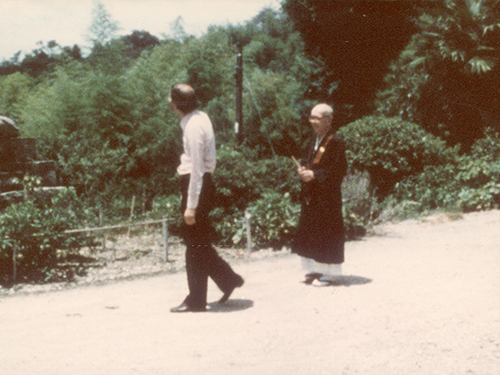
“Made as a ‘twin’ of A ilha dos amores, A ilha de Moraes is a poetic documentary on the enigmatic life of Wenceslau de Moraes, the great Portuguese writer who, like Paulo Rocha himself, had a profound fascination for Asian cultures and lived in Japan from 1912 until his death in 1929. Rocha, who served as a cultural attaché for his country in Japan from 1975 to 1983, visited places where Moraes was still remembered, interviewed the writer’s descendants, consulted archives and rummaged through diaries, photographs and manuscripts in order to establish an intimate dialogue with his life and work, whilst expanding to the history of Portugal, Europe and the Far East. Above all he set out on a new journey, from Lisbon to Macao and Kobe until he reached Tokushima, where Moraes lived through the final period of his life and where Rocha tracks down, between the city and the cemetery, the living presence of places and the respectful memories left behind by this remarkable writer. This film was developed in close collaboration with filmmaker and writer Haneda Sumiko, who was a founding member of Iwanami Productions, together with other filmmakers including, notably, Shinsuke Ogawa and Noriaki Tsuchimoto.”
Courtisane1
“Two of the most beautiful films of the ‘80s on Japan are shot by Paulo Rocha. A Ilha Dos Amores and A Ilha de Moraes are long studies-tributes to the life of Wenceslau de Moraes, the Portuguese poet who loved Japan where he spent most of his life. [...] These films, born after a preparation of over a decade, are the extraordinary result of a double love of their author, both for Moraes and for Japan (and already in the title there is the game of the anagram Moraes-Amores), with Rocha who ends up identifying with the character he studied, chasing the same ghosts, the two loves Oyone and Koharu, lost by the poet. ‘And have you ever met Koharu?’ An old Japanese man who had met Moraes asks him. It’s the last scene in the movie, and Rocha seems ready to remain on the Island of Love too.”
Marco Giusti2
« Si l’on met ensemble tous mes projets, y compris ceux qui n’ont pas été tournés, l’éventail des styles est très large, du goût pour le plan séquence à celui du collage à l’intérieur du plan. Disons que si les thèmes et les questions de mon cinéma ont beaucoup bougé, je continue de fonctionner à l’identique: par obsession. Je suis dévoré par certaines rencontres, certains endroits. Le travail de mise en scène est dans ce cadre une seconde nature. Face à mes films, on peut avoir le sentiment d’une mise en scène totalitaire, formalisée. Mais en vérité je ne perds jamais une seconde à réfléchir à l’endroit où je vais poser la caméra. Je vais à l’instinct, parce que je perçois l’espace de façon magnétique et très forte. J’essaye donc de me défendre, de me surprendre, en mettant dans mes films, chaque fois que je le peux, une part imprévisible de chaos. »
“Als men al mijn projecten vergelijkt, met inbegrip van diegenen die nooit gedraaid zijn, is het spectrum van stijlen vrij breed, van een voorkeur voor long takes tot de collage van het interieur van het kader. Laten we zeggen dat als de thema’s en de vragen van mijn cinema veel hebben bewogen, ik zelf op eenzelfde manier blijf werken: door obsessie. Ik word verslonden door sommige ontmoetingen, sommige plekken. Het werk van de mise en scène wordt in dat opzicht een tweede natuur. Bij mijn films zou men het gevoel kunnen krijgen van een totalitair, geformaliseerd soort mise en scène. Maar in werkelijkheid verlies ik nooit een seconde met nadenken over waar ik mijn camera zal plaatsen. Ik werk op instinct, omdat ik de ruimte op een magnetische en erg krachtige manier waarneem. Ik probeer dus mezelf te verdedigen, te verrassen, door in mijn films zo vaak als ik kan een onvoorspelbaar deeltje chaos binnen te brengen.”
“If one compares all my projects, including those that weren’t shot, the range of styles is very wide, from a taste for long takes to collages of the interior of the shot. Let’s say that if these themes and the questions of my cinema have shifted a lot, I continue to work in the same way: by obsession. I’m consumed by certain encounters, certain places. In this way, the work of the mise en scène is a second nature. Faced with my films, one could get the sense of a totalitarian, formalised mise en scène. But in reality I never waste a second thinking about where I’m going to put my camera. I go by instinct, because I perceive space in a magnetic way and forcefully. So I try to defend myself, surprise myself by bringing into my films, every time I can, an unpredictable part of chaos.”
Paulo Rocha in an interview with Liberation3

– Paulo Rocha with Kozo Okazaki (elumiere.net)
- 1Courtisane Festival 2019 program
- 2Courtisane Festival 2019 program
- 3Olivier Séguret, « Interview du cinéaste portugais Paulo Rocha », Libération, 13 janvier 1999.

